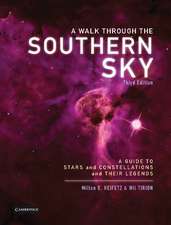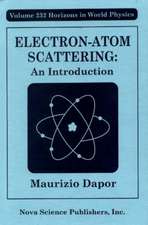Nuclear Matter in Different Phases and Transitions: Proceedings of the Workshop Nuclear Matter in Different Phases and Transitions, March 31–April 10, 1998, Les Houches, France: Fundamental Theories of Physics, cartea 95
Editat de Jean-Paul Blaizot, Xavier Campi, Marek Ploszajczaken Limba Engleză Paperback – 14 oct 2012
Din seria Fundamental Theories of Physics
-
 Preț: 495.16 lei
Preț: 495.16 lei - 20%
 Preț: 1002.37 lei
Preț: 1002.37 lei -
 Preț: 423.43 lei
Preț: 423.43 lei - 20%
 Preț: 819.48 lei
Preț: 819.48 lei - 18%
 Preț: 773.52 lei
Preț: 773.52 lei - 18%
 Preț: 948.21 lei
Preț: 948.21 lei - 18%
 Preț: 943.51 lei
Preț: 943.51 lei - 24%
 Preț: 794.89 lei
Preț: 794.89 lei - 15%
 Preț: 585.47 lei
Preț: 585.47 lei - 18%
 Preț: 941.47 lei
Preț: 941.47 lei - 18%
 Preț: 1220.64 lei
Preț: 1220.64 lei - 15%
 Preț: 583.50 lei
Preț: 583.50 lei - 18%
 Preț: 1226.94 lei
Preț: 1226.94 lei - 18%
 Preț: 939.89 lei
Preț: 939.89 lei -
 Preț: 391.98 lei
Preț: 391.98 lei - 18%
 Preț: 947.90 lei
Preț: 947.90 lei - 18%
 Preț: 1231.93 lei
Preț: 1231.93 lei - 18%
 Preț: 947.90 lei
Preț: 947.90 lei - 18%
 Preț: 946.31 lei
Preț: 946.31 lei - 18%
 Preț: 941.93 lei
Preț: 941.93 lei - 15%
 Preț: 643.29 lei
Preț: 643.29 lei - 18%
 Preț: 1222.99 lei
Preț: 1222.99 lei - 18%
 Preț: 989.42 lei
Preț: 989.42 lei - 18%
 Preț: 939.44 lei
Preț: 939.44 lei - 15%
 Preț: 635.52 lei
Preț: 635.52 lei - 15%
 Preț: 632.12 lei
Preț: 632.12 lei -
 Preț: 388.91 lei
Preț: 388.91 lei - 18%
 Preț: 774.45 lei
Preț: 774.45 lei -
 Preț: 388.91 lei
Preț: 388.91 lei - 15%
 Preț: 644.30 lei
Preț: 644.30 lei -
 Preț: 394.84 lei
Preț: 394.84 lei - 24%
 Preț: 586.69 lei
Preț: 586.69 lei - 15%
 Preț: 640.22 lei
Preț: 640.22 lei - 18%
 Preț: 1219.08 lei
Preț: 1219.08 lei
Preț: 399.61 lei
Nou
Puncte Express: 599
Preț estimativ în valută:
76.53€ • 78.09$ • 64.39£
76.53€ • 78.09$ • 64.39£
Carte tipărită la comandă
Livrare economică 26 februarie-12 martie
Preluare comenzi: 021 569.72.76
Specificații
ISBN-13: 9789401059343
ISBN-10: 9401059349
Pagini: 548
Ilustrații: XII, 532 p.
Dimensiuni: 160 x 240 x 29 mm
Greutate: 0.76 kg
Ediția:Softcover reprint of the original 1st ed. 1999
Editura: SPRINGER NETHERLANDS
Colecția Springer
Seria Fundamental Theories of Physics
Locul publicării:Dordrecht, Netherlands
ISBN-10: 9401059349
Pagini: 548
Ilustrații: XII, 532 p.
Dimensiuni: 160 x 240 x 29 mm
Greutate: 0.76 kg
Ediția:Softcover reprint of the original 1st ed. 1999
Editura: SPRINGER NETHERLANDS
Colecția Springer
Seria Fundamental Theories of Physics
Locul publicării:Dordrecht, Netherlands
Public țintă
ResearchCuprins
Section I Thermal and chemical equilibrium.- Probing thermalizing nuclear matter with hard photons.- Hadron multiplicities in high energy e+e?, p?p and pp collisions with a statistical - thermal model.- Phase transitions without thermodynamic limit.- The role of statistics and thermodynamics in nuclear multifragmentation.- Hydrodynamic description of very high energy heavy ion collisions.- Section II Non-equilibrium dynamics.- Hadronic transport model with a phase transition.- Baryon transport dynamics : from p — p to Pb — Pb collisions.- Semihard interactions in nuclear collisions based on a unified approach to high energy scattering.- Dynamics of the chiral phase transition.- Filamentation instability in ultrarelativistic heavy-ion collisions.- Section III Phase transitions and the critical behaviour.- Critical behaviour in finite temperature QCD.- Chaos as a signature of quark — hadron phase transition.- Universality of the off-equilibrium critical fragmentation.- Bose-Einstein condensation in trapped atomic gases.- Thermodynamics and cluster content of finite excited systems of classical particles with short and long range interactions.- Percolation approach to the liquid gas phase transition — Isospin degree of freedom.- Critical phenomena in finite systems.- Deuteron versus ?-particle condensation and precritical pair fluctuations in low density nuclear matter.- Section IV Hadronic matter and the quark — gluon plasma.- QCD phases at high density and instantons.- Colour deconfinement in high energy collisions.- The phase transition between the quark-gluon plasma and the hadronic matter : What can we learn from vector mesons?.- Quark gluon plasma in A + A collisions at CERN SPS.- Chemical equilibrium in ultra-relativistic nuclear collisions.- Flowphenomena as possible signals of the QCD phase transition.- Quark-hadron interactions in nuclear matter : Deconfinement signal.- Constraining a simple hadronization model of relativistic heavy-ion collisions using hadronic observables.- Probing chiral symmetry restoration with heavy ions.- Low mass dilepton production at the CERN SPS.- Strangeness and in-medium effects in heavy-ion collisions at SIS energies.- Bose-Einstein condensation in multipion systems.- Determination of emission times using two particle correlation.- Section V Multifragmentation, liquid — gas phase transition.- Boltzmann — Langevin approaches.- Liquid-gas phase transition in finite nuclei within fermionic molecular dynamics.- Multifragmentation — a dynamical or a statistical process?.- Multifragmentation in heavy ion reactions : Dynamical effects and thermalization.- The caloric curve of hot nuclei.- Critical behavior in nuclear multifragmentation : A determination of critical exponents and the scaling function.- Light particle probes of the dynamical evolution of multifragmentation reactions.- Cluster-cluster collisions : Fusion, phase transition and fragmentation phenomena.- On microscopic insights into metal cluster fragmentation.- List of participants.















